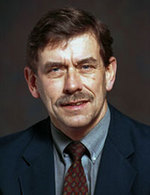5 questions about Japan's nuclear crisis answered by University of Michigan professors
Nuclear engineering experts at the University of Michigan are watching the aftereffects of the 9.0 magnitude earthquake and tsunami that hit Japan on March 11.
The damage from those events knocked out electricity needed to run cooling systems at nuclear complexes like Fukushima Dai-ichi nuclear plant, about 150 miles north of Tokyo on Japan’s northeastern coast.
The reactors, bundles of thousands thin pipes, each encasing uranium dioxide, are an incredibly hot and dense energy source that must be constantly cooled while in use and cooled for decades after they’ve been spent. Explosions at four of the sites at the complex have blown holes in the roofs of buildings adjacent to the reactors. There's a chance radiation might escape from pipes already exposed to air in the reactors and from drained cooling ponds holding spent rods.
It’s a crucial time for Japan, said William Martin, a professor and chair of nuclear engineering and radiological sciences at the University of Michigan.
Things could get better, or worse, very quickly, but local nuclear experts do not believe a catastrophic release of radiation such as the 1986 Chernobyl disaster in Ukraine is possible.
Today in Ann Arbor, U-M experts shed light on questions from AnnArbor.com about the crisis.

Bill Martin
“These explosions have been hydrogen explosions, so not in the reactor, but in the building that surrounds the reactor,” Martin said “It looks like there have been four. It appears four buildings have been damaged, two of them, the roofs are very damaged, and maybe two other have large holes in the roofs.”
2. What is a partial meltdown? When a partial meltdown occurs, it’s because fuel rods have become damaged, allowing for the release of some radioactive elements. University of Michigan experts suspect partial meltdowns at two of the reactor sites at the complex. Seawater is being pumped in to Reactor 2 to avoid a full meltdown.
3. Will radiation escape and harm the public? Because of the holes in the building caused by explosions, there is a greater danger that radiation can escape in the area, Martin said. He said he could not speculate as to how much radiation might escape, but said the problem would be worse than the 1979 Three Mile Island nuclear accident in Harrisburg, Penn. That plant also had cooling

John Lee
"I don’t think we’re looking at anything like Chernobyl, but it would be more than Three Mile Island," Martin said.
4. What are the hidden dangers at the Japan plant? University experts are more concerned about spent fuel in cooling ponds, Martin said. Spent fuel must be cooled for decades, and there is concern that pools at some reactor sites at the plant have lost water. This week, temperatures at the two reactor sites that have not yet had an explosion are increasing, and experts on site don’t know why.
5. Could it happen here? It’s not likely. Since 9-11, the government has shored up 104 nuclear energy plants around the country with measures to increase security. Some measures involved the creation of a variety of power supplies at each plant that make it virtually impossible to lose the power running cooling systems at nuclear reactor sites. The nearest nuclear plant to Ann Arbor is Monroe’s Fermi-2, a plant similar in design to Fukushima. Newer nuclear reactors in the United States have technologies that allow for cooling even during power blackouts without water being pumped in. In Japan, the succession of two major natural disasters trumped a series of back-up plans and overwhelmed the system at the Fukushima nuclear plant and elsewhere.
In the University of Michigan video below, experts from the department of nuclear engineering and radiological sciences discuss a few critical issues surrounding the nuclear crisis in Japan. They explain why a Chernobyl-style scenario is impossible and why a meltdown doesn't necessarily cause a catastrophic radiation release.
Juliana Keeping is a health and environment reporter for AnnArbor.com. Reach her at julianakeeping@annarbor.com or 734-623-2528. Follow Juliana Keeping on Twitter


Comments
Atasi
Fri, Mar 25, 2011 : 4:07 p.m.
Is The Radiation Menace Low In Japan? <a href="http://www.newscollective.com/blog/?p=4109" rel='nofollow'>http://www.newscollective.com/blog/?p=4109</a>
Bob Tinker
Sat, Mar 19, 2011 : 7:22 p.m.
Well, if these professors are so confident that the Fukushima reactors are safe, we should send them over to Japan to fix the cooling systems. Maybe their hubris will allow them to last longer than the heroic Japanese workers given the task of operating in a gamma ray environment - not! This flaccid attempt at disinformation is appalling.
A2rez
Sat, Mar 19, 2011 : 12:29 p.m.
U.S. media coverage on this has been remarkably terrible (this article by AA is one of the few I've read that at least makes an attempt to provide real information). Perhaps it is terrible for other issues, but (as is rarely the case), this is one I know something about. I think Dr. Lee offers good explanations; there is considerable information available that could help people better understand. The BBC has done a phenomenal job of consistently presenting balanced reporting on the issues with thorough background explanations and detailed, up-to-the-minute facts. The comments by their readers, largely foreign residents in Japan, are baffled by U.S. media hysteria -- not only because it is unwarranted, but because it detracts from real and serious problems - the plight and suffering of the survivors in northern Honshu. I guess our media think after Katrina, the 2004 tsunami in Aceh, and the earthquakes in Haiti and New Zealand, covering an extremely rare event like a nuclear plant level 5 accident is more likely to draw an audience than covering yet another shocked and suffering population. The media has done some real damage, but hey, next week, they'll be able to talk about all the people on the West coast who are getting sick from overdosing on KI pills.
jcj
Fri, Mar 18, 2011 : 7:42 p.m.
It is so hard to get what a reasonable person would call facts. The pro nuclear crowd will down play it. The anti nuclear crowd will try to make it look like Armageddon. ( And for those living near there it has to be) And finally our news sources will say what ever will get viewers.
FreedomOfSpeech
Fri, Mar 18, 2011 : 4:43 p.m.
Reports Of "Harmless" Radiation Reaching California Are a Whitewash Paul Joseph Watson - March 18, 2011 Exactly as we predicted would happen, authorities have cited "miniscule" levels of radiation reaching California as an excuse with which to downplay the threat to Americans of fallout crossing the Pacific from Japan, completely ignoring the fact that the bulk of the radiation from the two blasts at the Fukushima power plant will not reach the west coast until Monday. Full Article: <a href="http://www.infowars.com/reports-of-harmless-radiation-reaching-california-are-a-whitewash/" rel='nofollow'>http://www.infowars.com/reports-of-harmless-radiation-reaching-california-are-a-whitewash/</a>
FreedomOfSpeech
Fri, Mar 18, 2011 : 4:41 p.m.
tommy_t it's not just "nuclear fuel" in some of the Fukushima plants it's the MOX Mixture which is a combination of uranium & plutonium... ie... weapons grade and FAR FAR more deadly! I don't know what's worse the lies coming out of John Lee or the people using him as a source expert? I'll listen to likes of: Dr. Bob Bowman - Former U.S. Military Star Wars Head and 3 degrees in Nuclear Engineering Dr. Doug Rokke - Retired Major Ph.D. (USAR, retired) & former director of the U.S. Army's Depleted Uranium Project Others: <a href="http://www.infowars.com/stream.pls" rel='nofollow'>http://www.infowars.com/stream.pls</a> ----
ToddAustin
Sat, Mar 19, 2011 : 1:33 a.m.
Only reactor #3 contain MOX, which is a mix of plutonium and uranium, with the plutonium fraction something less than 10%. The plutonium may have been taken from decommissioned nuclear weapons, but in this dilute state, it is hardly weapons grade. What makes it dangerous is the poisonous nature of plutonium. If it is released, it's far more likely to cause health problems than is uranium. Of course, the spent fuel in all those storage pools also contains on the order of 1% plutonium, a result of the decay of the original uranium oxide.
tommy_t
Fri, Mar 18, 2011 : 3:42 p.m.
*• Reactor No. 1 fuel pool: 50 tons of nuclear fuel • Reactor No. 2 fuel pool: 81 tons • Reactor No. 3 fuel pool: 88 tons • Reactor No. 4 fuel pool: 135 tons • Reactor No. 5 fuel pool: 142 tons • Reactor No. 6 fuel pool: 151 tons • Also, a separate ground-level fuel pool contains 1,097 tons of fuel; and some 70 tons of nuclear materials are kept on the grounds in dry storage. ------------------------------------ *estimate by Marvin Resnikoff , radioactive waste management consultant - March 17, 2011 How do you handle this stuff?
xmo
Fri, Mar 18, 2011 : 3:41 p.m.
This sure sounds a lot different than what the professional news agency's are reporting! So, it sounds like we should build some clean energy nuclear power plants in the U.S.! Maybe one in Ann Arbor if it saves the planet.
linuxtuxguy
Fri, Mar 18, 2011 : 1:40 p.m.
8.9 magnitude? I thought that was officially updated to 9.0 after the experts reviewed more data?
Juliana Keeping
Fri, Mar 18, 2011 : 1:45 p.m.
Have just updated it. By March 14, the USGS and Japanese seismologists upgraded their estimate of the earthquake to 9.0.